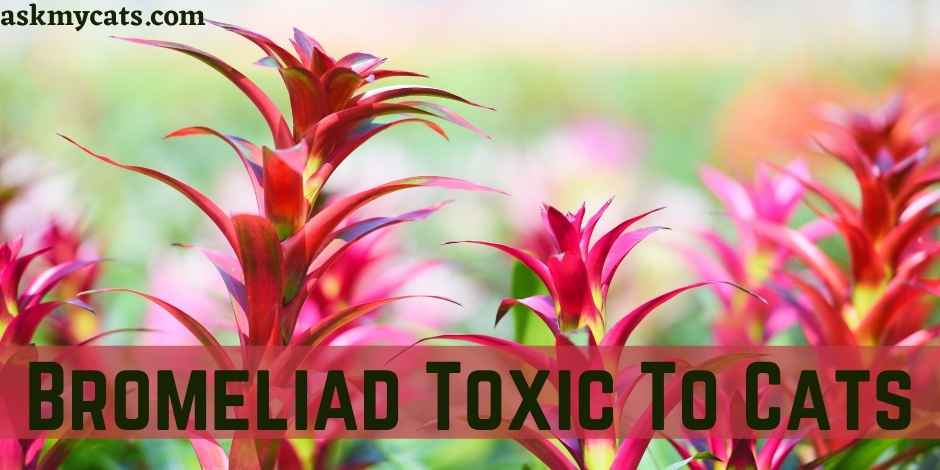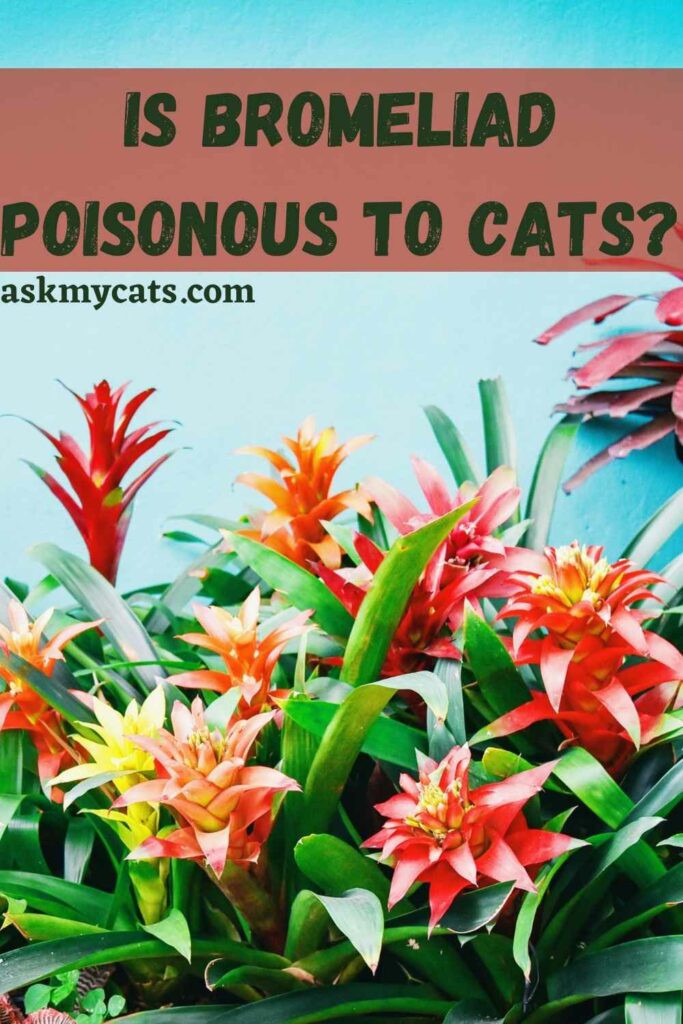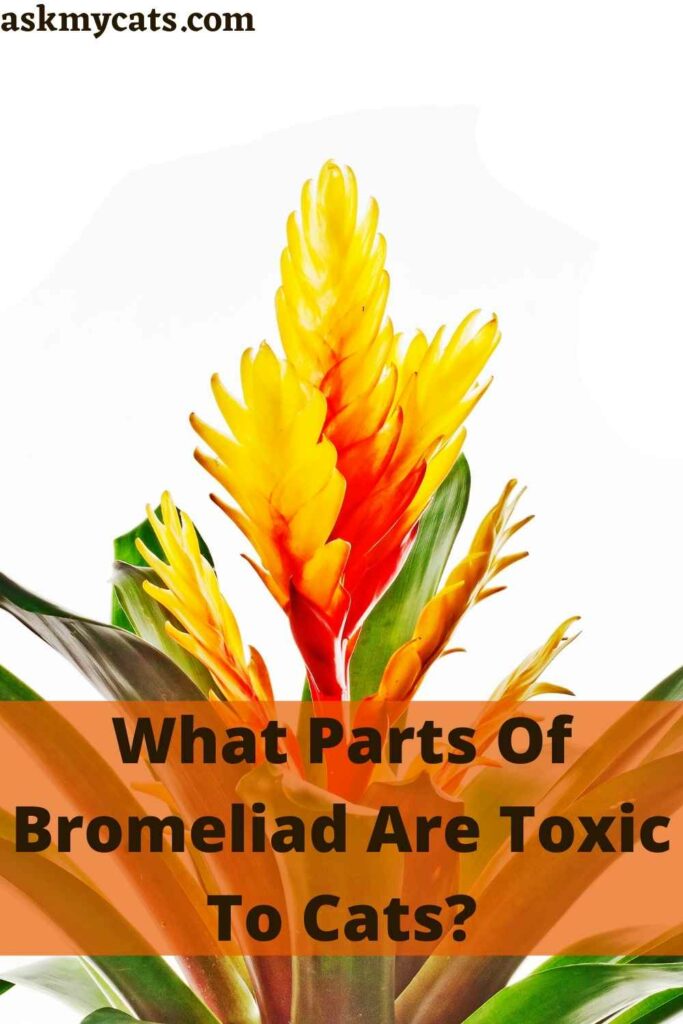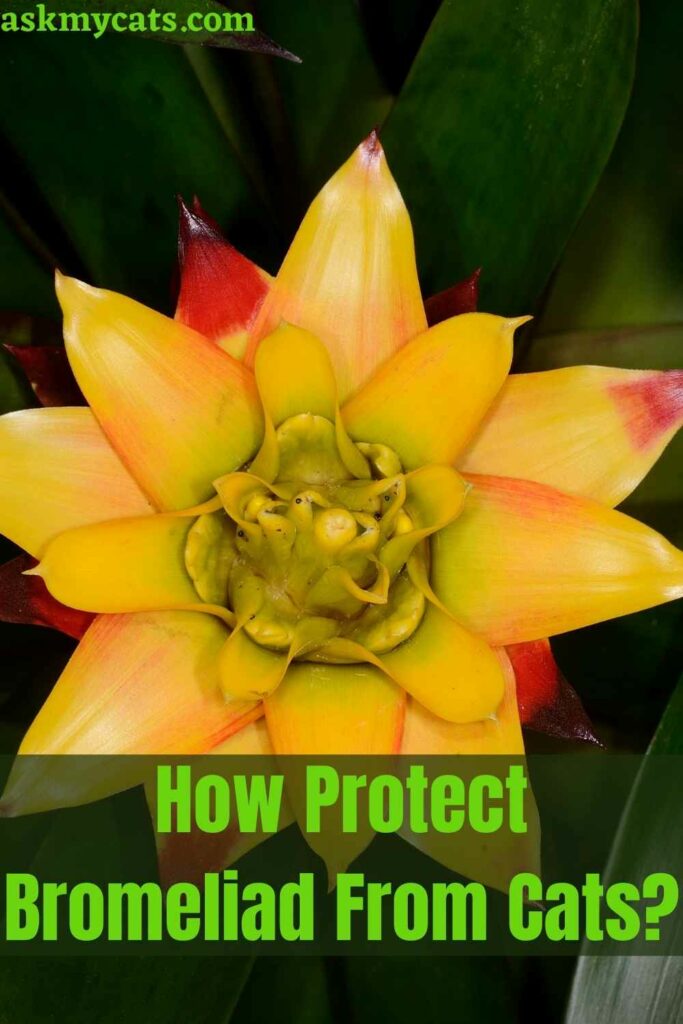Bromeliad is the common name for the Bromeliaceae family, which includes 75 genera and 3590 species. The monocot flowering plants are mostly native to tropical America, with a few exceptions in the West African tropics and the American subtropics.
When propagating a Bromeliad plant, Bromeliad growers confront a number of obstacles, one of which is determining whether they can cultivate the plant while still breeding their pets, particularly cats, and whether the plant is hazardous to cats.
So, is bromeliad toxic to cats?
No, the bromeliad is not toxic to cats. Cats are unaffected by any of the houseplants in the bromeliad family. Cat owners can exhale a sigh of relief since their feline companions occasionally munch on houseplants or grass.
This article will talk about the relationship between cats and bromeliad in detail.


Give Your Cat the Perfect Day
Get the Free Ebook!
What Is Bromeliad?
The Bromeliaceae family, which has 75 genera and 3590 species, is known as a bromeliad.
Many bromeliads have a structure produced by their densely overlapping leaf bases that may store water. The tank bromeliads, grey-leaved epiphyte Tillandsia species that collect water only from leaf structures called trichomes, and several desert-dwelling succulents are all members of the family.
Bromeliads are plants that can thrive in a variety of temperatures. Foliage comes in a variety of forms and sizes, ranging from needle-thin to broad and flat, symmetrical to asymmetrical, spiky to gentle.
The foliage, which grows in a rosette, is patterned and colored in a variety of ways. The colors of the leaves range from maroon to gold, with shades of green in between.
Varieties can have leaves that are red, yellow, white, or cream. Others feature purple, scarlet, or cream spots, while others have varied colors on the tops and bottoms, and species like Tillandsia cyanea have a clove-like aroma.
Bromeliaceae plants can be found throughout the Americas in their native habitats. In Africa, one species (Pitcairnia Feliciana) may be found.
They can be found at elevations ranging from sea level to 4200 meters, in environments ranging from rainforests to deserts.
There are 1814 epiphytes, lithophytes, and terrestrial species among the 1814. As a result, these plants can be found in the Andean highlands, from northern Chile to Colombia, in the Sechura Desert of coastal Peru, in Central and South American cloud forests, and in the southern United States, from southern Virginia to Florida to Texas, and in far southern Arizona.
Is Bromeliad Poisonous To Cats?
No, the bromeliad is not poisonous to cats.

Many people are worried about bromeliad plants being toxic to cats.
Bromeliads are tropical plants known for their distinctive leaves, flexibility, and ease of care.
Bromeliads may also offer a tropical atmosphere to your space with their brilliant colors and unusual textures.
The Bromeliaceae family has hundreds of genera and thousands of species classed as bromeliad – monocot angiosperm (flowering).
They’re also popular since they can grow terrestrially (in soil), saxicolous (on rocks), or epiphytically (on trees) (in the air).
Bromeliads provide rich, colorful blossoms without the mess of dirt for people whose cats tend to dig in potted plants.
Although many species classify as bromeliad, none of them are poisonous or toxic to cats, dogs, or other common indoor pets.
Bromeliad plants are listed as non-toxic by the ASPCA (American Society for the Prevention of Cruelty to Animals).
Cats are not poisoned by bromeliads, which means that all of the houseplants in the bromeliad family are safe for cats and even dogs.
People who own these creatures can breathe a sigh of relief because they occasionally graze greenery, such as houseplants and grass.
Bromeliads will help clean the air (purify volatile organic chemicals or VOCs) within your home that is released by paints, furniture, cleaning supplies, printers, copiers, and dry-cleaned garments, among other things, in addition to decorating and creating a tropical-like appeal in your home.
Finally, bromeliads are not poisonous to humans, save for cats. There are other species, however, that you should keep out of your children’s reach because their sap may trigger allergic reactions, such as slight dermatitis.
Bromeliad leaves are commonly chewed by kittens, and while they are not deadly, they can make them sick if the cat is allergic to the plant. Alternatively, they may choke on the leaves, resulting in a serious condition such as asphyxia.
To ease your anxiety, bromeliads are not detrimental to your cat’s health. This means you can breed your pet and grow your bromeliads at the same time.
Despite the fact that the plant is not dangerous to your pets, cats, and dogs in this situation, you must take precautions to keep your kittens away from it.
Bromeliad leaves are also chewed by kittens, and while they are not harmful, they could make them sick if they are allergic to the plant.
They could also choke on the leaves, resulting in a dangerous case of asphyxia. When you realize your pet has eaten a bromeliad plant, you should take them to a veterinarian.
What Parts Of Bromeliad Are Toxic To Cats?
No part of bromeliad is toxic to cats.

Cats are not poisoned by any portion of the Bromeliad plant, i.e, these plants are not harmful to cats.
However, if your cat eats the plant’s leaves, blooms, seeds, sap, or roots, they may develop digestive problems.
Bromeliads are not dangerous to cats, according to the Morris Veterinary Center PSC in Minnesota; nonetheless, even if the plant is not poisonous, cats frequently vomit when they eat it. Furthermore, plants might pose a choking threat at times.
The Blushing Bromeliad is non-toxic to cats, according to the American Society for the Prevention of Cruelty to Animals, but if a cat eats it, a veterinarian or the ASPCA should be contacted.
Bromeliads are popular houseplants and outdoor potted plants, according to the University of Florida Institute of Food and Agricultural Sciences.
In tropical and subtropical areas, they are often utilized for landscaping. The leaves and flowers of certain kinds are brilliantly colored. Bromeliads include Spanish moss and pineapples, according to the UF IFAS.
Your cat may experience moderate stomach discomfort, vomiting, or diarrhea. The symptoms will usually go away once the plant has been removed from the cat’s body. It’s simply the body’s reaction to new foods.
However, if symptoms persist or worsen, you should see a veterinarian to be sure your cat isn’t having an allergic response.
Although the plant is not dangerous, it is not recommended that your cats, dogs, or children eat interior house plants.
Many farmers use fertilizers to help their plants grow faster. Unfortunately, hazardous chemicals may be present in these fertilizers, posing a risk.
Potassium (K), phosphorus (P), and nitrogen (N) are commonly found in fertilizers used on plants like bromeliads (N). These are denoted by the letters NPK (or variation) and a number that indicates the concentration (30-10-10 NPK equals 30 portions N to equal 10 parts P and K).
Copper, zinc, iron, manganese, cobalt, boron, and molybdenum are also present. Your cats may become poisoned if you give them large dosages of these chemicals. Low amounts can induce stomach problems.
Symptoms Of Bromeliad Poisonous In Cats?
Symptoms of bromeliad poisonous in cats are: –
Although your cat should be alright if it eats a bromeliad plant, the same cannot be said for other varieties of flowers.
Knowing the signs of plant poisoning in cats will help you spot the problem if it happens. Poisoning in cats can cause any of the following symptoms:
- Vomiting
- Diarrhea
- Difficulty breathing
- Salivation (drooling)
- Twitches
- Swelling of skin or body
- Lethargy
- Loss of appetite
- Decreased energy
- Increased urination
- Increased thirst
If you are concerned that your cat is exhibiting these symptoms, contact the Poison Control Center for advice. The ASPCA Poison Control is the best Poison Hotline for pet poisonings. 888-426-4435 is the phone number to call.
Take your cat to the vet if the symptoms are severe or have been present for a long time. If you can’t obtain an appointment with your normal veterinarian, try visiting an emergency pet clinic.
How To Handle Bromeliad Plants?
You can handle bromeliad without protective gear since they are not toxic to cats and humans.
Bromeliad plants are not poisonous or harmful, thus no protective equipment is required when transplanting, cleaning, or watering them.
When working with fertilizer, though, it is best to take precautions. Wear gloves and a face mask while mixing the fertilizer ingredient with water to produce a liquid solution. The fumes from the mixture might irritate the lungs and cause skin burns in certain persons.
Over your clothes, you might want to wear an apron or a jacket. The fertilizer’s chemicals, as well as the plant-soil itself, can stain your clothes.
Make sure you have enough ventilation while mixing your fertilizer and applying it to your plants. Avoid getting caught in a breeze that will spread the mist. To avoid getting the mixture in your eyes, you may want to wear safety goggles or other eye protection.
How Protect Bromeliad From Cats?
You can protect bromeliad from cats by following these tips.

Your bromeliads must be kept safe from your cats; this is in the best interests of your plant’s health and growth.
Other obstacles occur from growing and breeding, aside from them chewing the plants and getting sick from them.
With your cat nearby, your bromeliad pot could be in danger because cats like to hop around and knock things over.
Another issue is the cats burrowing into the pot; the roots of the bromeliad may be uprooted, and the plant may perish as a result.
The following tips would help protect your bromeliads from your pets:
- You can use a spray bottle on your cat if it gets too close to the bromeliad. If you did this on a regular basis, the cat wouldn’t be able to go close to the plant.
- Sprays that repel insects are also quite useful. Simply spray your bromeliad and your cat will stay away from it. Vinegar should be avoided because it can hurt your plants.
- You might put pebble stones in your bromeliad pot but leave enough room for your soil to be moistened; this will keep your cats from digging through it.
- Place your plants out of reach of your cats as a last resort.
Why Are Cats Attracted To Bromeliad?
Cats might be attracted to bromeliad because of its colorful leaves.
Cats are notorious for devouring houseplants and their foliage. This is why cat owners are extremely cautious and cautious when purchasing house plants in order to avoid purchasing harmful plants. Bromeliads are safe to keep around cats at all times.
Even if the cat eats the bromeliad, there is no danger to the cat’s health.
The plant’s brightly colored leaves entice the cat. They enjoy the sap’s flavor as well. Additionally, if your cat is gassy, it may devour the leaves. Your cat may consume the plant or the leaves due to a lack of nutrients.
Alternatives For Bromeliad
Alternatives for bromeliad are: –
1. Spider Plants
Spider plants are easy to grow inside, adapt well to the vases they’re placed in, and can live in low light. They come in a variety of kinds that are all non-poisonous to cats and require minimal maintenance to maintain them alive.
Their spider-like leaves, which sprout from a central root in the ground, entice certain feline companions to investigate, consume, or chew on them. However, if that is a problem, try hanging them out of reach of your kitty.
2. African Violets
These plants require more sunlight and care than spider plants, but they have a variety of appealing blossom colors. Despite the fact that African violets are not dangerous to cats, they are typically cultivated in little pots that curious felines can readily knock over.
Find a larger, heavier pot and increase the bottom weight to prevent your kitten from unintentionally dispersing soil into your carpet.
3. True Palms
The majority of these large flowerhead plants, such as Parlor, Areca, and Ponytail types, thrive in warm climes. If you want to keep palms in your house with cats, make sure the variety can flourish indoors first.
Second, make sure the name doesn’t contain the words cycad or sago. Those aren’t real palms if they have. Sago palms are a Cycad species that are extremely hazardous to cats and dogs.
Frequently Asked Questions
What plants can kill a cat?
The ASPCA has compiled a list of the top 17 hazardous plants to keep your cat away from. Lilies. Lilium family members are known to be extremely poisonous to cats. Marijuana. The palm of the Sago Bulbs of Tulips and Narcissus. Azalea/Rhododendron. Oleander.
Can Bromeliad make a cat sick?
Many house plants have been reported to make cats sick. Bromeliads, on the other hand, are not on that list. Bromeliads, which are highly attractive and colorful house plants, are absolutely safe to grow around dogs. The cat may occasionally chew on the leaves, but this is quite safe for them in moderation.Many house plants have been reported to make cats sick. Bromeliads, on the other hand, are not on that list. Bromeliads, which are highly attractive and colorful house plants, are absolutely safe to grow around dogs. The cat may occasionally chew on the leaves, but this is quite safe for them in moderation.
How do I stop my cat from eating bromeliads?
Your cat’s health should not be affected by your cat is eating the bromeliad plant. However, it may not be acceptable to you because it harms the plant. There are a few things you can do to keep your cat from devouring your bromeliads. Keep the plant away from it. Keep the plant out of your cat’s reach. This is a simple and quick solution. When your cat consumes the plant, provide positive-negative reinforcement. Tell them not to eat the plant, and if they move away from it, reward them with a tiny treat or words of affection. You can also add some citrus or orange juice to the mix. Mix a little citrus or orange juice with water and spritz your plant with it. This will deter your cat from attacking the plant, and the mixture will not harm your bromeliad.
Final Words
When you have a cat, it’s difficult to keep house plants alive. Cats are poisoned by a variety of plants. Bromeliads, on the other hand, are not such plants. The plant is completely safe to keep around cats. It is safe to keep the non-toxic plant around cats and other pets.
If you have any questions, ask us in the comments section.
